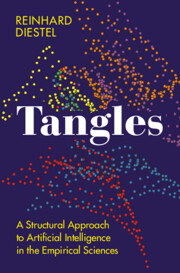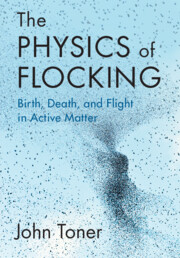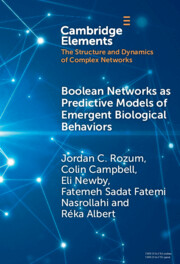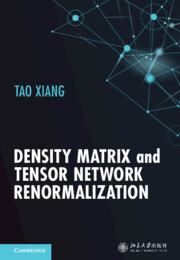2080 results in Statistical Physics
6 - Examples from data science
- from Part II - Tangles in Different Contexts
-
- Book:
- Tangles
- Published online:
- 16 May 2024
- Print publication:
- 23 May 2024, pp 53-72
-
- Chapter
- Export citation
1 - The idea behind tangles
- from Part I - Tangles
-
- Book:
- Tangles
- Published online:
- 16 May 2024
- Print publication:
- 23 May 2024, pp 3-14
-
- Chapter
-
- You have access
- Export citation
4 - Examples from the natural sciences
- from Part II - Tangles in Different Contexts
-
- Book:
- Tangles
- Published online:
- 16 May 2024
- Print publication:
- 23 May 2024, pp 33-40
-
- Chapter
- Export citation
10 - Choosing the feature system
- from Part III - The Mathematics of Tangles
-
- Book:
- Tangles
- Published online:
- 16 May 2024
- Print publication:
- 23 May 2024, pp 157-168
-
- Chapter
- Export citation

Tangles
- A Structural Approach to Artificial Intelligence in the Empirical Sciences
-
- Published online:
- 16 May 2024
- Print publication:
- 23 May 2024

The Physics of Flocking
- Birth, Death, and Flight in Active Matter
-
- Published online:
- 16 May 2024
- Print publication:
- 23 May 2024

Boolean Networks as Predictive Models of Emergent Biological Behaviors
-
- Published online:
- 04 March 2024
- Print publication:
- 28 March 2024
-
- Element
- Export citation

Density Matrix and Tensor Network Renormalization
-
- Published online:
- 18 January 2024
- Print publication:
- 31 August 2023
Frontmatter
-
- Book:
- Density Matrix and Tensor Network Renormalization
- Published online:
- 18 January 2024
- Print publication:
- 31 August 2023, pp i-iv
-
- Chapter
- Export citation
9 - DMRG with Nonlocal Basis States
-
- Book:
- Density Matrix and Tensor Network Renormalization
- Published online:
- 18 January 2024
- Print publication:
- 31 August 2023, pp 137-153
-
- Chapter
- Export citation
8 - Implementation of Symmetries
-
- Book:
- Density Matrix and Tensor Network Renormalization
- Published online:
- 18 January 2024
- Print publication:
- 31 August 2023, pp 123-136
-
- Chapter
- Export citation
16 - Renormalization of Quantum Transfer Matrices
-
- Book:
- Density Matrix and Tensor Network Renormalization
- Published online:
- 18 January 2024
- Print publication:
- 31 August 2023, pp 243-257
-
- Chapter
- Export citation
7 - Real-Space DMRG
-
- Book:
- Density Matrix and Tensor Network Renormalization
- Published online:
- 18 January 2024
- Print publication:
- 31 August 2023, pp 103-122
-
- Chapter
- Export citation
Abbreviations
-
- Book:
- Density Matrix and Tensor Network Renormalization
- Published online:
- 18 January 2024
- Print publication:
- 31 August 2023, pp xx-xx
-
- Chapter
- Export citation
14 - Classical Transfer Matrix Renormalization
-
- Book:
- Density Matrix and Tensor Network Renormalization
- Published online:
- 18 January 2024
- Print publication:
- 31 August 2023, pp 217-233
-
- Chapter
- Export citation
17 - MPS Solution of QTMRG
-
- Book:
- Density Matrix and Tensor Network Renormalization
- Published online:
- 18 January 2024
- Print publication:
- 31 August 2023, pp 258-272
-
- Chapter
- Export citation
1 - Introduction
-
- Book:
- Density Matrix and Tensor Network Renormalization
- Published online:
- 18 January 2024
- Print publication:
- 31 August 2023, pp 1-34
-
- Chapter
-
- You have access
- Export citation
4 - Tensor Network Representation of Operators
-
- Book:
- Density Matrix and Tensor Network Renormalization
- Published online:
- 18 January 2024
- Print publication:
- 31 August 2023, pp 61-76
-
- Chapter
- Export citation
5 - Tensor Network Ansatz of Wave Functions
-
- Book:
- Density Matrix and Tensor Network Renormalization
- Published online:
- 18 January 2024
- Print publication:
- 31 August 2023, pp 77-95
-
- Chapter
- Export citation
18 - Dynamical Correlation Functions
-
- Book:
- Density Matrix and Tensor Network Renormalization
- Published online:
- 18 January 2024
- Print publication:
- 31 August 2023, pp 273-292
-
- Chapter
- Export citation

